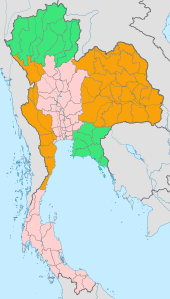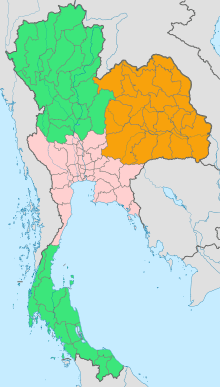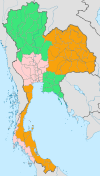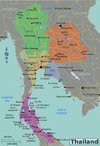Regions of Thailand




Thailand is variably divided into different sets of regions, the most notable of which are the six-region grouping used in geographic studies, and the four-region grouping consistent with the Monthon administrative regional grouping system formerly used by the Ministry of Interior. These regions are the largest subdivisions of the country.
In contrast to the administrative divisions of the provinces of Thailand, the regions no longer have an administrative character, but are used for geographical, statistical, geological, meteorological, or touristic purposes.
Grouping systems
A six-region system is commonly used for geographical and scientific purposes. This system dates to 1935.[1] It was formalised in 1977 by the National Geographical Committee, which was appointed by the National Research Council. It divides the country into the following regions:
- Northern Thailand
- Northeastern Thailand
- Western Thailand
- Central Thailand
- Eastern Thailand
- Southern Thailand
The four-region system, used in some administrative and statistical contexts, and also as a loose cultural grouping, includes the western and eastern regions within the central region, while grouping the provinces of Sukhothai, Phitsanulok, Phichit, Kamphaeng Phet, Phetchabun, Nakhon Sawan, and Uthai Thani in the northern region. This is also the regional system most commonly used on national television, when discussing the weather or regional events. It divides the country into the following regions:
The Thai Meteorological Department divides the country into six regions for meteorological purposes.[2] It differs from the four-region system in that the east is regarded as a separate region, the south is divided into east and west coasts, and Nakhon Sawan and Uthai Thani are grouped in the central region.
The Tourism Authority of Thailand (TAT) formerly used a five region system. It now divides the country into six regions for tourism purposes.[3]
- Northern Thailand
- Northeastern Thailand
- Central Thailand
- Eastern Thailand
- Southern Thailand
- Western Thailand
Comparison
See also
References
- ↑ Mundus. Wissenschaftliche Verlagsgesellschaft. 1981. p. 65. Retrieved 17 January 2012.
- ↑ "Home; Weather". Thai Meteorlogical Department. Retrieved 4 October 2018.
- ↑ "Thailand travel guide, destinations and maps". Tourism Authority of Thailand (TAT). Retrieved 2018-10-05.
